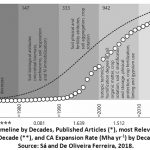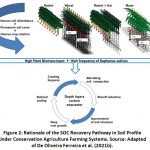Currently, Brazil has 36.8 million hectares under Conservation Agriculture (CA) 1, accounting for ~75% of total grain production area. South Brazil main grain producer States (Paraná and Rio Grande do Sul) were the pioneers in the adoption of CA in the early 1970s but the system was only farming scaled up after the 1990s. In 1990, the area under CA was 0.9 million ha (M ha), with an annual rate of 0.081 M ha per year, and in 2000 it was already 14.0 M ha, with an annual rate of 1.64 M ha per year. The CA area doubled in 2010 up to 30.3 M ha, with an annual rate of 1.51 M ha per year and in 2016/17 reached the current area 1 (Figure 1), placing Brazil in second position in the world CA adoption 2. CA based on principles of minimum soil disturbance, permanent soil cover and diverse crop rotation including cover crops in single use or in consortium filling up all the windows between cash crops 3 is a key strategy to restore and to maintain SOC stock, improve soil quality, sustain a diverse microbiome and increase crop yield 4, 5, 6, 7, 8.
 |
Figure 1: Timeline by Decades, Published Articles (*), most Relevants Events in each Decade (**), and CA Expansion Rate (Mha yr-1) by Decade (***). Source: Sá and De Oliveira Ferreira, 2018. |
SOC Recovery Pathway Beyond Topsoil under Conservation Agriculture Farming Systems
To promote SOC recovery in soil layers beyond topsoil with Conservation Agriculture, it is necessary to fulfill some requirements. Among them: maintaining the area under continuous (over the years) high organic material input and increase radish oil frequency in cropping system (Figure 2). It’s important to mention that annual precipitation should be medium / high (≈ 1600 to 1750 mm year-1) and well distributed during winter (cultivation period of radish oil) to provide water and soil moisture, favoring cations transport along the soil profile and improving root development. In addition, the topsoil should have pH > 6,0 that allows calcium vertical translocation to subsoil with infiltration allowing deep root growth. These practices will:
a) Create biopores – the forage radish works as a biological soil ripper, creating biopores that are preferential pathways for root growth of the next crops 9. In addition, it’s necessary to keep average high plant density as 17 to 25 plants per m2 and high radish frequency on crop rotation. As a consequence, the infiltration is increased, the runoff is controlled and the precipitation plant use efficiency is increased resulting in higher biomass input.
b) Soil decompaction – As a consequence of biopores creation, soil is decompacted, creating favorable conditions for root growth 10, 9, 11 and microbiote activity and diversity is enhanced since the aeration is improved 12, that are the most efficient source of organic C to soil 13. In addition, the biopores formed by oilseed radish roots are stable and works as preferential paths for linked the topsoil with subsoil 14.
c) Improve soil structure – Continuous pores associated with high biological activity and bioproducts input are essential to bio improvement of soil structure (through cimentant agents that increase aggregate stability and enhance soil macroaggregation buid up) with that the water infiltration through soil profile is stimulate 6. In addition, this improvement of soil structure also affect positively the mesoporosity that are strategic to increase plant water availability 15. Finally, it is necessary to adopt a crop rotation system with high C-biomass input and a diverse and deep root system to form SOC-rich soil layers and provide C source to vertical distribution along the soil profile reaching in medium to long-term the deepest layers. In this case, the deep and continuous biopores could connect the shallow layer and deep layer, supporting C translocation through the soil profile 16, 17, 18.
These actions (Figure 2) need to be associated with minimum soil disturbance, improvement of soil fertility, pH increase, maintaining nutrients availability and high plant biomass input. In Brazilian tropical soils, the chemical improvement of subsoil has been associated to high crop performance 19. 5 adjusted a linear model with carbon recovery as independent variable and highlighted these processes importance: i) For top layers (0-15 cm) [SOC Recovery = 25.9 (pH) + 70.9 (Low intensity crop rotation) + 93.4 (Med intensity crop rotation) + 1.3 (Altitude) + 219.7 (Average temperature) – 13.6 (Max temperature)] and subsurface (60-100 cm) [SOC Recovery = – 40.0 (pH) + 21.5 (Ca2+) + 60.6 (Low intensity crop rotation) + 0.1 (Altitude) + 2.4 (Max temperature)]. In that study, the authors also showed that SOC recovery was smaller for areas with low crop rotation intensity, higher Al3+ levels and lower levels of Mg2+ and P. Sites with medium / high crop rotation intensity, lower levels of Al3+ and higher levels of P, Ca2+, Mg2+, and K+ showed higher C recovery 5. In this context, the high and diverse crop residue input should be combined with management that enhance the C stabilization mechanisms.
Therefore, the higher SOC recovery under conservation agriculture is related to crop intensity and diversity, microbial diversity, greater frequency of radish and consequently soil decompaction in the arable layer, soil structure improvement, moisture maintenance, improved soil fertility and reduction of soil disturbance (Fig. 2).
 |
Figure 2: Rationale of the SOC Recovery Pathway in Soil Profile Under Conservation Agriculture Farming Systems. Source: Adapted of De Oliveira Ferreira et al. (2021b). |
Conclusion
To promote SOC recovery in deepest soil layers with Conservation Agriculture, it is necessary to fulfill some requirements. Among them: maintaining the area under continuous (over the years) high organic material input and radish frequency. These practices will: i) Create bio pores; ii) Alleviating soil compaction, creating favorable conditions for iii) root growth, that are the most efficient source of organic C to soil and finally iv) Improve soil structure keeping soil moisture levels high. These actions need to be associated with minimum soil disturbance, improvement of soil fertility, pH increase and maintaining nutrients availability.
References
- Sá, J.C.M.,De Oliveira Ferreira, A. (2018). The soil science in the evolution of no-till system in Brazil. SBCS Bulletim (Brazilian Society of Soil Science), 44, p. 54-57.
- Kassam, A., Friedrich, T., Derpsch, R. (2019). The global spread of conservation agriculture. J. Environ. Stud. 76, 29-51. https://doi.org/10.1080/00207233.2018.1494927.
CrossRef - (2018). Basic Principles of Conservation Agriculture. Rome: Food and Agriculture Organization of the United Nations. http://www.fao.org/faostat/en/.
- De Oliveira Ferreira, A.; Amado, T.; Rice, C.W.; Diaz, D.A.R.; Keller, C.; Inagaki, T.M. (2016). Can no-till grain production restore soil organic carbon to levels natural grass in a subtropical Oxisol? Agriculture, Ecosystems & Environment, 229, 13-20. https://doi.org/10.1016/j.agee.2016.05.016.
CrossRef - De Oliveira Ferreira, A.; Amado, T.J.C.; Rice, C.W.; Diaz, D.A.R.; Briedis, C.; Inagaki, T.M.; Goncalves, D.R.P. (2018a). Driving factors of soil carbon accumulation in Oxisols in long-term no-till systems of South Brazil. Science of The Total Environment, 622-623, 735-742. https://doi.org/10.1016/j.scitotenv.2017.12.019.
CrossRef - De Oliveira Ferreira, A., Sá, J.C.M., Lal, R., Tivet, F., Briedis,, Inagaki, T.M., Gonçalves, D.R.P., Romaniw, J. (2018b). Macroaggregation and soil organic carbon restoration in a highly weathered Brazilian Oxisol after two decades under no-till. Science of The Total Environment, 621, 1559-1567. https://doi.org/10.1016/j.scitotenv.2017.10.072.
CrossRef - De Oliveira Ferreira, A.; Sá, J.C.M.; Lal, R.; Amado, T.J.C.; Inagaki, T.M.; Briedis, C.; Tivet, F. (2021a). Can no-till restore soil organic carbon to levels under natural vegetation in a subtropical and tropical typic quartzipisamment?. Land Degradation & Development, 32, 1742-1750. https://doi.org/10.1002/ldr.3822.
CrossRef - De Oliveira Ferreira, A.; Amado, T.J.C.; Rice, C.W.; Gonçalves, D.R.P.; Ruiz Diaz, D.A. (2021b). Comparing on-farm and long-term research experiments for soil carbon recovery of conservation agriculture in Southern Brazil. Land Degradation & Development, 32, 3365-3376. https://doi.org/10.1002/ldr.4015.
CrossRef - Chen, G., Weil, R.R. (2010). Penetration of cover crop roots through compacted soils. Plant and Soil, 331: 31-43. https://doi.org/10.1007/s11104-009-0223-7.
CrossRef - Amado, T.J.C, Peres, R.B., Costa, J.A., Nicoloso, R.S., Teixeira, T. (2007). A safra recorde analisada pelos mapas de rendimento no RS. Plantio Direto, 18-123.
- Inagaki, T.M.; Sá, J.C.M.; Tormena, C.A.; Dranski, A.; Muchalak, A.; Briedis, C.; De Oliveira Ferreira, A.; Giarola, N.F.; Silva, A.P. (2021). Mechanical and biological chiseling impacts on soil organic C stocks, root growth, and crop yield in a long-term no-till system. Soil & Tillage Research, v. 211, p. 104993. https://doi.org/10.1016/j.still.2021.104993.
CrossRef - Passinato, J.H.; Amado, T.J.C; Acosta, J.A.A.; Kassam, A. (2021). Soil health checkup of Brazilian conservation agriculture farming systems. In: 8th World Congress on Conservation Agriculture, Bern, Switzerland. 1-10.
- Fulton‐Smith, S., & Cotrufo, M.F. (2019). Pathways of soil organic matter formation from above and belowground inputs in a Sorghum bicolor bioenergy crop. Global Change Biology-Bioenergy, 11, 971-987. https://doi.org/10.1111/gcbb.12598.
CrossRef - Williams, S.M., Weil, R.R. (2004). Crop cover root channels may alleviate soil compaction effects on soybean crops. Soil Science Society of America Journal 68, 1403-1409. https://doi.org/10.2136/sssaj2004.1403.
CrossRef - Dexter, A.R. (2004). Soil physical quality: Part III: Unsaturated hydraulic conductivity and general conclusions about S-theory. Geoderma, 120, 227-239. https://doi.org/10.1016/j.geoderma.2003.09.006.
CrossRef - Chabbi, A., Kögel-Knabner, I., Rumpel, C., 2009. Stabilized carbon in subsoil horizons is located in spatially distinct parts of the soil profile. Soil Biology and Biochemistry, 41, 256-261. https://doi.org/10.1016/j.soilbio.2008.10.033.
CrossRef - Rumpel, C.; Kogel-Knabner, I. (2011). Deep soil organic matter-a a key but poorly understood component of the terrestrial C cycle. Plant and Soil, 338, 143-158. https://doi.org/10.1007/s11104-010-0391-5.
CrossRef - Nicoloso, R.S.; Rice, C.W.; Amado, T.J.C.; Costa, C.N.; Akley, E.K. (2018). Carbon saturation and translocation in a no-till soil under organic amendment. Agriculture, Ecosystems & Environment 264, 73-84. https://doi.org/10.1016/j.agee.2018.05.016.
CrossRef - Dalla Nora, D., Amado, T.J.C. (2013). Improvement in chemical attributes of Oxisol subsoil and crop yields under no-till. Agronomy Journal, 105, 1393-1403. https://doi.org/10.2134/agronj2013.0031.
CrossRef

